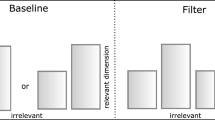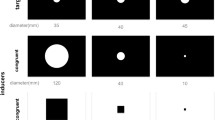Abstract
It is well documented that changes in the physiological states of the perceiver–actor influence the perception of action capabilities. However, because experimental procedures of most studies involved a limitless availability for stimuli visual encoding and perceptual strategies, it remains difficult to adopt a single position among the large range of alternative interpretations for impaired perception. A reaching-to-grasp paradigm under breathing restriction was adapted from Graydon et al. (Cogn Emot 26:1301–1305, 2012) to standardize the time for encoding of stimuli information and narrowed the involvement of perceptual strategies. In the present study, we propose a highly controlled environment where the discrete information is presented during 300 ms, congruently with neurophysiological studies focused on visuomotor transformation. An underestimation of the perception of action capabilities is found under breath restriction, suggesting that 300 ms for stimuli encoding is sufficient to induce altered visuomotor brain transformations when limiting the involvement of perceptual strategies. This result suggests that such behavior could refer to an impaired brain potentiation of the perceptual occurrence, providing strong hypotheses on the brain dynamics of sensorimotor integration that underlie impaired perception of action capabilities in stressful situations.



Similar content being viewed by others
References
Bhalla, M., & Proffitt, D. R. (1999). Visual-motor recalibration in geographical slant perception. Journal of Experimental Psychology: Human Perception and Performance, 25, 1076–1096.
Binkofski, F., & Buxbaum, L. J. (2013). Two action systems in the human brain. Brain and Language,. doi:10.1016/j.bandl.2012.07.007.
Borghi, A. M., & Riggio, L. (2009). Sentence comprehension and simulation of object temporary, canonical and stable affordances. Brain Research, 1253, 117–128. doi:10.1016/j.brainres.2008.11.064.
Cohen, J. (1988). Statistical power analysis for the behavioural sciences. New-York: Academic press.
Daviaux, Y., Mignardot, J.-B., Cornu, C., & Deschamps, T. (2014). Effects of total sleep deprivation on the perception of action capabilities. Experimental Brain Research, 232, 2243–2253.
Deschamps, T., Hug, F., Hodges, P. W., & Tucker, K. (2014). Influence of experimental pain on the perception of action capabilities and performance of a maximal single leg hop. The Journal of Pain, 15, 271.e1–271.e7.
di Pellegrino, G., Fadiga, L., Fogassi, L., Gallese, V., & Rizzolatti, G. (1992). Understanding motor events: a neurophysiological study. Experimental Brain Research, 91, 176–180.
Ellis, R., & Tucker, M. (2000). Micro-affordance: the potentiation of components of action by seen objects. British Journal of Psychology, 91, 451–471.
Eysenck, M. W., & Derakshan, N. (2011). New perspectives in attentional control theory. Personality and Individual Differences, 50, 955–960.
Eysenck, M. W., Derakshan, N., Santos, R., & Galvo, M. G. (2007). Anxiety and cognitive performance: attentional Control Theory. Emotion, 7, 336–353.
Fernandez-Duque, D., Baird, J. A., & Posner, M. I. (2000). Executive attention and metacognitive regulation. Consciousness and Cognition, 9, 288–307. doi:10.1006/ccog.2000.0447.Frern.
Fischer, M. H. (2000). Estimating reachability: whole body engagement or postural stability? Human Movement Science, 19(297), 318.
Franca, M., Turella, L., Canto, R., Brunelli, N., Allione, L., Andreasi, N. G., & Fadiga, L. (2012). Corticospinal facilitation during observation of graspable objects: a transcranial magnetic stimulation study. PLoS One, 7, e49025.
Franchak, J. M., van der Zalm, D. J., & Adolph, K. E. (2010). Learning by doing: action performance facilitates affordance perception. Vision Research, 50, 2758–2765.
Garbarini, F., & Adenzato, M. (2004). At the root of embodied cognition: cognitive science meets neurophysiology. Brain and Cognition, 56, 100–106. doi:10.1016/j.bandc.2004.06.003.
Gibson, J. J. (1966). The senses considered as perceptual systems. Boston: Houghton Mifflin.
Gibson, J. J. (1977). The theory of affordances. Perceiving, acting, and knowing: toward an ecological psychology. Hillsdale: Erlbaum Associates, Inc.
Graydon, M. M., Linkenauger, S. A., Teachman, B. A., & Proffitt, D. R. (2012). Scared stiff: the influence of anxiety on the perception of action capabilities. Cognition and Emotion, 26(1301–1315), 1–16.
Guardia, D., Conversy, L., Jardri, R., Lafargue, G., Thomas, P., Dodin, V., et al. (2012). Imagining one’s won and someone else’s body actions: dissociation in anorexia nervosa. PLoS One, 7, e43241. doi:10.1371/journal.pone.0043241.
Guardia, D., Lafargue, G., Thomas, P., Dodin, V., Cottencin, O., & Luyat, M. (2010). Anticipation of body-scaled action is modified in anorexia nervosa. Neuropsychologia, 48, 3961–3966.
Hackney, A. L., & Cinelli, M. E. (2013). Young and older adults use body-scaled information during a non-confined aperture crossing task. Experimental Brain Research, 225, 419–429.
Hamilton, A.F., & Grafton, S.T. (2007). The motor hierarchy: from kinematics to goals and intentions. In Rosetti,Y., Kawato, M., Haggard, P. (eds.), Attention and performance.
Handy, T. C., Grafton, S. T., Shroff, N. M., Ketay, S., & Gazzaniga, M. S. (2003). Graspable objects grasp attention when the potential for action is recognized. Nature Neuroscience, 6, 421–427.
Higuchi, T., Hatano, N., Soma, K., & Imanaka, K. (2009). Perception of spatial requirements for wheelchair locomotion in experienced users with Tetraplegia. Journal of Physiological Anthropology, 28, 15–21. doi:10.2114/jpa2.28.15.
Higuchi, T., Murai, G., Kijima, A., Seya, Y., Wagman, J. B., & Imanaka, K. (2011). Athletic experience influences shoulder rotations when running through apertures. Human Movement Science, 30, 534–549.
Hirose, N., & Nishio, A. (2001). The process of adaptation to perceiving new action capabilities. Ecological Psychology, 13, 49–69.
Huijbers, W., Pennartz, C. M., Beldzik, E., Domagalik, A., Vinck, M., Hofman, W. F., & Daselaar, S. M. (2014). Respiration phase-locks to fast stimulus presentations: implications for the interpretation of posterior midline “deactivations”. Humain Brain Mapping, 35, 4932–4943. doi:10.1002/hbm.22523.
Janelle, C. M. (2002). Anxiety, arousal and visual attention: a mechanistic account of performance variability. Journal of Sport Sciences, 20, 237–251.
Jonides, J., Lewis, R. L., Nee, D. E., Lustig, C. A., Berman, M. G., & Sledge Moore, K. (2008). The mind and brain of short-term memory. Annual Review of Psychology, 59, 193–224. doi:10.1146/annurev.psych.59.103006.093615.
Kanai, R., & Rees, G. (2011). The structural basis of interindividual differences in human behaviour and cognition. Nature Reviews Neuroscience, 12, 231–242.
Kilner, J. M., Friston, K. J., & Frith, C. D. (2007). Predictive coding: an account of the mirror neuron system. Cognitive Processing, 8, 159–166.
Kingdom, F. A. A., & Prins, N. (2009). Psychophysics: a practical introduction. San Diego: Elsevier.
Lee, A. C., Harris, J. P., Atkinson, E. A., & Fowler, M. S. (2001). Disruption of estimation of body-scaled aperture width in Hemiparkinson’s disease. Neuropsychologia, 39, 1097–1104.
Linkenauger, S. A., Witt, J. K., & Proffitt, D. R. (2011). Taking a hands-on approach: apparent grasping ability scales the perception of perceived object size. Journal of Experimental Psychology: Human Perception and Performance, 37, 1432–1441.
Linkenauger, S. A., Witt, J. K., Stefanucci, J. K., Bakdash, J. Z., & Proffitt, D. R. (2009). The effects of handedness and reachability on perceived distance. Journal of Experimental Psychology: Human Perception and Performance, 35, 1649–1660.
Lopresti-Goodman, S. M., Richardson, M. J., Baron, R. M., Carello, C., & Marsh, K. L. (2009). Task constraints on affordance boundaries. Motor Control, 13, 69–83.
Lopresti-Goodman, S. M., Turvey, M. T., & Frank, T. D. (2013). Negative hysteresis in the behavioral dynamics of the affordance “graspable”. Attention, Perception, and Psychophysics, 75, 1075–1091.
Makris, S., Hadar, A. A., & Yarrow, K. (2011). Viewing objects and planning actions: on the potentiation of grasping behaviours by visual objects. Brain and Cognition,. doi:10.1016/j.bandc.2011.08.002.
Mark, L. S. (1987). Eyeheight-scaled information about affordances: a study of sitting and stair climbing. Journal of Experimental Psychology: Human Perception and Performance, 13, 361–370.
Mealor, A. D., & Dienes, Z. (2013). The speed of metacognition: taking time to get to know one’s structural knowledge. Consciousness and Cognition, 22, 123–136. doi:10.1016/j.concog.2012.11.009.
Natraj, N., Poole, V., Mizelle, J. C., Flumini, A., Borghi, A. M., & Wheaton, L. A. (2013). Context and hand posture modulate the neural dynamics of tool-object perception. Neuropsychologia, 51, 506–519.
Nieuwenhuys, A., & Oudejans, R. R. D. (2012). Anxiety and perceptual-motor performance: toward an integrated model of concepts, mechanisms, and process. Psychological Research, 76, 747–759.
Nieuwenhuys, A., Pijpers, J. R., Oudejans, R. R. D., & Bakker, F. C. (2008). The influence of anxiety on visual attention in climbing. Journal of Sport and Exercise Psychology, 30(171), 185.
Noël, M., Bernard, A., & Luyat, M. (2011). The overestimation of performance: a specific bias of aging? Gériatrie et psychologie neuropsychiatrie du vieillissement, 9, 287–294. doi:10.1684/pnv.2011.0290.
Oldfield, R. C. (1971). The assessment and analysis of handedness: the Edinburgh inventory. Neuropsychologia, 9, 97–113.
Oliveira, J. M., Volchan, E., Vargas, C. D., Gleiser, S., & David, I. A. (2012). Box for interaction with objects (BIO): a new device to synchronize the presentation of objects with electrophysiological recordings. Behavior Research Methods, 44, 1115–1120.
Pijpers, J. R., Oudejans, R. R. D., & Bakker, F. C. (2007). Changes in the perception of action possibilities while climbing to fatigue on a climbing wall. Journal of Sports Sciences, 25, 97–110.
Pijpers, J. R., Oudejans, R. R. D., Bakker, F. C., & Beek, P. J. (2006). The Role of anxiety in perceiving and realizing affordances. Ecological Psychology, 18, 131–161.
Proverbio, A. M. (2012). Tool perception suppresses 10–12 Hz μ rhythm of EEG over the somatosensory area. Biological Psychology, 91, 1–7.
Proverbio, A. M., Adorni, R., & D’Aniello, G. E. (2011). 250 ms to code for action affordance during observation of manipulable objects. Neuropsychologia, 49, 2711–2717.
Sakurai, R., Fujiwara, Y., Ishihara, M., Higuchi, T., Uchida, H., & Imanaka, K. (2013). Age-related self-overestimation of step-over ability in healthy older adults and its relationship to fall risk. BMC Geriatrics, 13, 44. doi:10.1186/1471-2318-13-44.
Smith, J. G., Harris, J. P., Khan, S., Atkinson, E. A., Fowler, M. S., Ewins, D., et al. (2011). Motor asymmetry and estimation of body-scaled aperture width in Parkinson’s disease. Neuropsychologia, 49, 3002–3010. doi:10.1016/j.neuropsychologia.2011.06.025.
Sweller, J. (2011). Cognitive Load Theory. In J. P. Mestre & B. H. Ross (Eds.), The pscyhology of learning and motivation (pp. 37–76). San Diego: Elsevier.
Teachman, B. A., & Gordon, T. L. (2009). Age differences in anxious responding: older and calmer, unless the trigger is physical. Psychology and Aging, 24, 703–714.
Teachman, B. A., Smith-Janik, S. B., & Saporito, J. (2007). Information processing biases and panic disorder: relationships among cognitive and symptom measures. Behaviour Research and Therapy, 45, 1791–1811.
Temprado, J.-J., Zanone, P. G., Monno, A., & Laurent, M. (1999). Attentional load associated with performing and stabilizing preferred bimanual patterns. Journal of Experimental Psychology: Human Perception and Performance, 25, 1579–1594.
Thill, S., Caligiore, D., Borghi, A. M., Ziemke, T., & Baldassarre, G. (2013). Theories and computational models of affordance and mirror systems: an Integrative Review. Neuroscience and Biobehavioral Reviews, 37, 421–491.
Warren, W. H. (1984). Perceiving affordances: visual guidance of stair climbing. Journal of Experimental Psychology: Human Perception and Performance, 10, 683–703.
Weast, J. A., Shockley, K., & Riley, M. A. (2011). The influence of athletic experience and kinematic information on skill-relevant affordance perception. The Quarterly Journal of Experimental Psychology, 64, 689–706.
Wilson, M. (2008). From processing efficiency to attentional control: a mechanistic account of the anxiety-performance relationship. International Review of Sport and Exercise Psychology, 1, 184–201.
Author information
Authors and Affiliations
Corresponding author
Rights and permissions
About this article
Cite this article
Daviaux, Y., Cremoux, S., Tallet, J. et al. An enhanced experimental procedure to rationalize on the impairment of perception of action capabilities. Psychological Research 80, 224–234 (2016). https://doi.org/10.1007/s00426-015-0653-1
Received:
Accepted:
Published:
Issue Date:
DOI: https://doi.org/10.1007/s00426-015-0653-1




